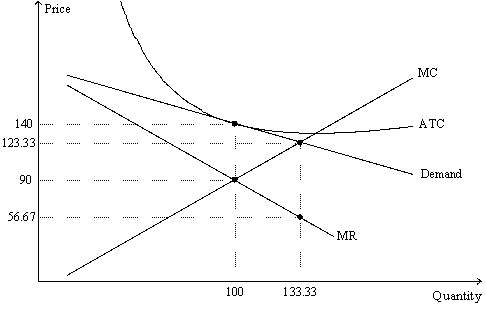A) the demand curve will be perfectly elastic.
B) price exceeds marginal cost.
C) marginal cost must be falling.
D) marginal revenue exceeds marginal cost.
F) All of the above
Correct Answer

verified
Correct Answer
verified
Multiple Choice
In a monopolistically competitive industry,a firm's demand curve also represent its
A) marginal revenue.
B) marginal cost.
C) average revenue.
D) profit.
F) A) and B)
Correct Answer

verified
Correct Answer
verified
Multiple Choice
When a firm exits a monopolistically competitive market,the individual demand curves faced by all remaining firms in that market will
A) shift in a direction that is unpredictable without further information.
B) shift to the right.
C) shift to the left.
D) remain unchanged.It is the supply curve that will shift.
F) A) and C)
Correct Answer

verified
Correct Answer
verified
Multiple Choice
Long-run profit earned by a monopolistically competitive firm is driven to the competitive level due to a(n)
A) change in the technology that the firm utilizes.
B) shift of its demand curve.
C) shift of its supply curve.
D) increase in the firm's average cost of production.
F) A) and C)
Correct Answer

verified
Correct Answer
verified
Multiple Choice
Which of the following is an example of a monopolistically competitive industry?
A) computer operating systems
B) tennis balls
C) movies
D) cable television
F) A) and C)
Correct Answer

verified
Correct Answer
verified
Multiple Choice
Figure 16-8
The figure is drawn for a monopolistically-competitive firm.  -Refer to Figure 16-8.In order to maximize its profit,the firm will choose to produce
-Refer to Figure 16-8.In order to maximize its profit,the firm will choose to produce
A) 100 units of output,and its profit will be positive.
B) 100 units of output,and its profit will be zero.
C) 133.33 units of output,and its profit will be negative.
D) 133.33 units of output,and its profit will be zero.
F) A) and C)
Correct Answer

verified
Correct Answer
verified
Multiple Choice
Table 16-6
Traci's Hairstyling is one salon among many in the market for hairstyling.The following table presents cost and revenue data for haircuts at Traci's Hairstyling.
 -Refer to Table 16-6.If the government forced Traci's to produce at the efficient scale of output,what is the maximum profit Traci's could earn?
-Refer to Table 16-6.If the government forced Traci's to produce at the efficient scale of output,what is the maximum profit Traci's could earn?
A) $77
B) $80
C) $84
D) $96
F) B) and D)
Correct Answer

verified
Correct Answer
verified
Multiple Choice
A firm can earn economic profits in the long run
A) only when the market is a monopoly.
B) only when the market is a monopoly or monopolistically competitive.
C) only when the market is monopolistically competitive or perfectly competitive.
D) when the market is perfectly competitive,monopolistically competitive,or monopolistic.
F) B) and D)
Correct Answer

verified
Correct Answer
verified
Multiple Choice
Critics of advertising argue that advertising
A) creates desires that otherwise might not exist.
B) hinders competition.
C) often fails to convey substantive information.
D) All of the above are correct.
F) A) and C)
Correct Answer

verified
Correct Answer
verified
Multiple Choice
A monopolistically competitive market has characteristics that are similar to
A) a monopoly only.
B) a competitive firm only.
C) both a monopoly and a competitive firm.
D) neither a monopoly nor a competitive firm.
F) C) and D)
Correct Answer

verified
Correct Answer
verified
True/False
The term excess capacity refers to the fact that a firm operates on the upward-sloping portion of its average-total-cost curve.
B) False
Correct Answer

verified
Correct Answer
verified
Multiple Choice
If a monopolistically competitive firm can increase its level of production and lower its average total cost of production at the same time then
A) the firm has a product-variety opportunity.
B) the firm has excess capacity.
C) the firm has a business-stealing opportunity.
D) the firm is producing a quantity of output higher than its efficient scale of production.
F) A) and B)
Correct Answer

verified
Correct Answer
verified
Multiple Choice
Table 16-6
Traci's Hairstyling is one salon among many in the market for hairstyling.The following table presents cost and revenue data for haircuts at Traci's Hairstyling.
 -Refer to Table 16-6.Suppose the government forced Traci's to produce at the efficient scale of output.Who would be better off as a result of this policy? Who would be worse off as a result of this policy?
-Refer to Table 16-6.Suppose the government forced Traci's to produce at the efficient scale of output.Who would be better off as a result of this policy? Who would be worse off as a result of this policy?
A) Traci's would be better off;consumers would be worse off.
B) Consumers would be better off;Traci's would be worse off.
C) No one would be better off;consumers would be worse off.
D) No one would be better off;no one would be worse off.
F) B) and D)
Correct Answer

verified
Correct Answer
verified
Multiple Choice
Keebleco knows that it produces and sells very tasty crackers.Nabiscer knows that it produces and sell dull crackers.According to the signaling theory of advertising,
A) both Keebleco and Nabiscer have incentives to spend large amounts of money on advertising their crackers.
B) Keebleco has an incentive to spend a large amount of money on advertising its crackers,but Nabiscer does not.
C) Nabiscer has an incentive to spend a large amount of money on advertising its crackers,but Keebleco does not.
D) neither Keebleco nor Nabiscer has an incentive to spend a large amount of money on advertising their crackers.
F) A) and C)
Correct Answer

verified
Correct Answer
verified
True/False
The claim that advertising reduces the elasticity of demand is likely to be made by a defender of advertising.
B) False
Correct Answer

verified
Correct Answer
verified
Multiple Choice
If firms in a particular market similar or sell identical products,then the market is (i) Perfectly competitive. (ii) Monopolistically competitive. (iii) An oligopoly.
A) (i) or (ii) only
B) (ii) or (iii) only
C) (i) or (iii) only
D) (i) only
F) C) and D)
Correct Answer

verified
Correct Answer
verified
True/False
Free entry eliminates long-run profits for firms in competitive and monopolistic industries.
B) False
Correct Answer

verified
Correct Answer
verified
Multiple Choice
Which of the following statements regarding monopolistic competition is not correct?
A) In the long-run equilibrium,price equals average total cost.
B) In the long-run equilibrium,firms earn zero economic profit.
C) In the long-run equilibrium,firms charge a price above marginal cost.
D) In the long-run equilibrium,firms produce a quantity in excess of their efficient scale.
F) None of the above
Correct Answer

verified
Correct Answer
verified
Multiple Choice
An important difference between the situation faced by a profit-maximizing monopolistically competitive firm in the short run and the situation faced by that same firm in the long run is that in the short run,
A) price may exceed marginal revenue,but in the long run,price equals marginal revenue.
B) price may exceed marginal cost,but in the long run,price equals marginal cost.
C) price may exceed average total cost,but in the long run,price equals average total cost.
D) there are many firms in the market,but in the long run,there are only a few firms in the market.
F) A) and B)
Correct Answer

verified
Correct Answer
verified
Multiple Choice
Table 16-3
The following table shows the output produced by each of the top eight firms in four industries as well as the total industry output for those industries.
 -Refer to Table 16-3.Which industry has the lowest concentration ratio?
-Refer to Table 16-3.Which industry has the lowest concentration ratio?
A) Industry A
B) Industry B
C) Industry C
D) Industry D
F) A) and D)
Correct Answer

verified
Correct Answer
verified
Showing 161 - 180 of 521
Related Exams